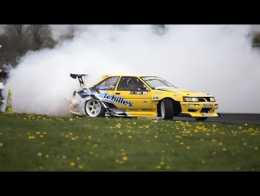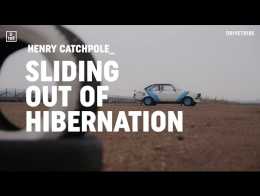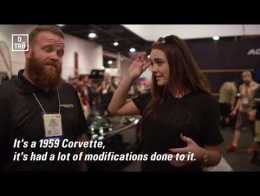So you’ve decided that you want to learn to drift. At this point I’m going to assume that you’ve procured a suitable rear-wheel-drive car, preferably one with a manual gearbox and enough power to break traction.
Before you go crazy, digging into your savings, selling a kidney, remortgaging the house, tearing apart a perfectly good and comfortable road car and rebuilding it into a bone-rattling pro-level drift machine it might be a good idea to see if you actually enjoy this drift malarky. Step one is to get out on track, but in order to get the most out of your new machine there are some basic and essential drift modifications that you should do beforehand…
1. ARE YOU SITTING COMFORTABLY?
As there’s no standard-sized human, car manufacturers have to cater for a huge range of shapes and sizes when designing seats. As a result, while they might be comfortable on a long journey and offer a wide scope of adjustment, they often tend to be lacking in the support department. When you’re skilfully drifting your car around a corner, or changing direction quickly, the last thing you want to be doing is sliding about in your seat and holding onto the steering wheel for support! Changing the driver’s seat in your car for a fixed-back racing seat and harness are the best modifications that you can do for driver feedback, trust me.
Now it might not do much for comfort on the motorway, and it’ll make getting in and out of the car awkward, but you’ll instantly notice an improvement in your awareness of exactly what the car is doing as you corner, as every little movement in the chassis is transferred to your body. As an added bonus, bucket seats tend to be mounted lower than standard seats and recliners too – providing that you can still see over the wheel, this is a good thing; by lowering your weight within the car you’re also lowering the car’s centre of gravity, which helps with handling. Ideally you’ll want to change both driver and passenger seats at the same time, but if you’re on a budget then you can get away with just changing the driver’s seat for the time being. In fact, leaving the passenger seat as a recliner can make it easier to get spare wheels and tyres in the back of the car!
Keep an eye on eBay and in online racing communities for secondhand seats that have just expired their FIA date – FIA homologated seats are certified for five years from manufacturer, and after that they can’t be used in many official racing series, whatever their condition. For drift practice however, they’re perfect, and you can pick up some real bargain seats in great condition.
2. SUSPENSION
Your car’s standard springs and shocks are probably fine for everyday driving, but for extra control and adjustment for drifting, you’re going to want to invest in some aftermarket suspension. Opt for uprated shocks and firmer lowering springs, or complete coilover units if your budget allows.
Coilovers allow you to set your car’s ride height precisely, and adjust it as needed. Many models also offer adjustable damping and camber adjustment, so you can fine-tune your suspension to suit the circuit you’re driving on and your driving style. Even if you don’t want to get into making fine adjustments to your suspension, a set of off-the-shelf coilovers will offer decreased body roll, improved handling and feedback, and more control when drifting.
Lowering your car will alter its alignment, so you may also wish to consider changing suspension alignment arms for reinforced adjustable units too, allowing you extra scope to set the car up just how you want. Finally, a set of uprated tie rods, or steering arms, are a wise choice – not only can it buy you a few extra degrees of steering lock, but there’s a lot of force put upon the tie rods when drifting at excessive angles, and the stock rods can bend or break over time.
3. IT MAKES ALL THE DIFFERENTIAL…
Your rear-wheel drive car will have come with one of two types of rear differential from the factory – either one of the open variety, or a limited-slip differential (LSD). The purpose of a limited slip differential is to stop the wheel with the least traction from receiving the majority of the power, which is what happens when you try and peel out in a car with an open differential.
There are several different types of LSD which distribute the drive between left and right wheels in different ways, however the most suitable for drifting is an aftermarket mechanical clutch plate-type. These are usually offered in 2-way and 1.5-way configurations. What’s the difference? Well, in a 2-way LSDs the differential can apply 100% torque to both wheels under both acceleration and deceleration, however with a 1.5-way, the LSD can apply 100% torque on acceleration, but only 50% on deceleration. For drifting, stick to a 2-way unit.
For the budget-conscious, a standard viscous or torsen LSD will be sufficient for the time being, but you may find that it isn’t working as reliably as it should after excessive use or high mileage. They can often be tightened up using shims, but all you're doing is delaying the inevitable. Open differentials can also be made suitable for drifting with a little home engineering. By opening the diff casing and welding the spider gears together, an open diff essentially becomes a locked unit, so that all of the power is sent to both rear wheels equally, no matter what. This is ideal for drifting, but makes the car difficult to drive at low speeds and frankly horrible to live with on the road, so I wouldn’t recommend doing it to your daily driver!
4. BURNING RUBBER
It’s safe to assume that, if you’re doing it right, then drifting is going to wear out your rear tyres pretty quickly. Rather than waiting around for the tyre guy to swap your spare rubber over, pick up a couple of pairs of spare rear wheels for your car, and mount some part-worn tyres on them before your next practice day. Then, when a pair heads off to that great tyre pile in the sky, swap them straight out and keep on drifting.
While it’s important to use a set of grippy front tyres, when you first start out drifting then the easiest way to learn without breaking the bank is using part-worn rears. Then, once you get used to breaking traction and controlling slides at relatively low speeds you can progress onto budget new tyres and build up your consistency. Modern pro level drift cars use super soft compounds for maximum grip, but when using these it takes a large amount of speed, power and commitment to break traction, so don’t be tempted to jump straight in by buying the best tyres you can afford!
Depending on the surface you’re sliding on and how much power your car has, you can expect to go through anything from a couple of pairs of tyres on a wet drift day, up to in excess of ten pairs on a dry day – so take plenty of spares! It’s worth taking a trip around the local tyre fitters in your area and letting them know that you’ll take any tyres of a certain size off them – they usually have to pay to dispose of them otherwise, so you’re helping them out in the long run!
5. HANDBRAKE IMPROVEMENTS
A vertical hydraulic handbrake is the option of choice for the pros, but isn't really necessary when learning
It's often referred to as 'the drift wand' – if you pull it, magic happens! Of course your car already has a handbrake, but it probably needs a bit of tweaking to make it strong, durable and reliable enough for drifting. Firstly you should make sure that there’s no slack in your handbrake cable, and that it’s not stretched or worn – if it is then replace it, pronto. Also make sure that you’ve plenty of meat left on your rear pads and that they’re biting nicely when you pull the handbrake.
A spin turn button is a simple and cheap handbrake modification that turns your stock handbrake into a fly-off-style item
At some point in the future you’re probably going to want to change your standard cable-operated setup for a hydraulic fly-off vertical brake, but for the time being your standard setup will do just fine. One tiny modification that will make a huge difference when using your handbrake while drifting is fitting a turn spin button, sometimes called a ‘drift button’. This replaces your handbrake’s standard button and converts it into a fly-off brake by disengaging the ratchet mechanism when the button is turned in one direction. To reengage the ratchet for parking, simply turn the button back the other way. They’re cheap, take minutes to fit, are MOT-friendly and available to fit most cars.
AND A BONUS ONE: SEAT TIME!
Spending time driving and learning your cars handling characteristics is by far the best way to improve
Without a doubt the most important thing you can do to your car if you want to improve its driftability is to actually drive it! Money spent on practice days will go a lot further than adding extra, unneeded parts that you probably won’t feel the benefit of yet. Spend as much time in the seat as possible, learning how your car drives and how to overcome its faults and niggles and you’ll find it much easier to jump in anything and make it drift.
Notice that ‘power’ is missing from this list? If you learn to drift in a difficult-to-handle, low-powered car you’ll find it much easier when you move up into a higher powered car than if you do it the other way around. Lower powered cars tend to teach good drifting technique, whereas in a high powered car it’s easy to rely on the power to break traction.
So what are you waiting for? Get out there and get drifting…
THANK YOU FOR READING



















تعليقات
إرسال تعليق
we will soon reply on your comment